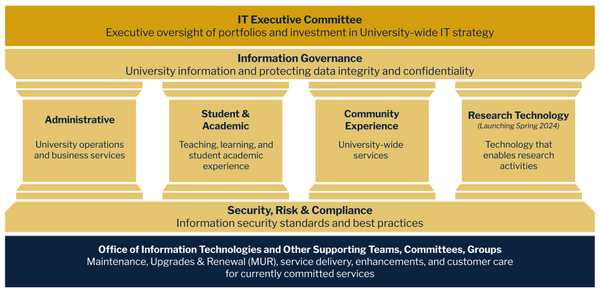
My last blog explained roadmaps and how multi-year, departmental IT planning works with the University Strategic Framework. Today, I examine the high-level IT Stewardship process, including the committees' domain and membership.
The IT Stewardship committee structure enables us to plan collectively with leadership across the University so we can execute projects that align with university priorities and strategic direction. Units have always brought IT projects forward to improve various technology and processes at the university. These projects were brought forward one or two at a time and “prioritized” by one or two members of University leadership, often without consideration for what other big initiatives were in play in other areas of the university.
This isolated prioritization led to capacity conflicts for OIT and created challenges related to change fatigue and heroic technology delivery (which leads to staff burnout). The new IT Stewardship process will help us to act as ‘one university’, providing transparency into the priorities across the institution.
Each Stewardship committee aligns with a particular set of consumers of IT services. The Administrative Committee prioritizes projects that are primarily focused on employees of the university–usually staff. The Student and Academic Committee prioritizes projects that focus mostly on faculty and students. The Research Committee focuses mostly on faculty who conduct research, post-docs, and other principal investigators (PI). The Community Experience Committee focuses on technology that impacts almost everyone at the university: Wi-Fi, parking, dining, email, communication platforms and so on. The Security, Risk and Compliance Committee considers technology projects that are focused on cybersecurity, regulatory compliance, or identified risks to the university such as drones or chemicals on campus.
The Technology Advisory Group (TAG) has a more complicated role and serves two primary purposes. First, it prioritizes the IT Foundational projects, which comprise a large number of “back-office technology” initiatives every year. Second, the TAG also oversees the entire demand and capacity portfolio for all IT Projects. They help to balance the load, set the cadence of projects, remove obstacles, and generally ensure the smooth operation of IT governance processes.
If projects are smaller, less risky, and not complicated, the TAG can prioritize those to move forward, even though that smaller initiative aligns more closely with one of the pillar committees. For instance, the Registrar’s Office recently proposed a project that uses mostly Registrar resources to create a comprehensive learner record (CLR) for students. OIT was able to “contribute” resources to the CLR project, and the project was not considered risky or high enough impact to require its prioritization by the Student and Academic Committee.
After each committee prioritizes the projects, they are sent to the TAG who will develop an overall IT Investment portfolio once per year. In most cases, the portfolio includes three scenarios: one based on risk and must-do projects, another focused on leveraging opportunities and strategic initiatives to take ND to the next level, and a third that blends the first two with a focus on practicality.
The Executive Committee considers the scenarios and makes suggestions. TAG then modifies the final approved IT Portfolio for consideration, which is then presented to the Budget Working Group (BWG) for funding. You can find more information about the Annual IT Planning Cycle, the IT Stewardship Committee Annual Flow, and the High-Level Structural Process on the OIT website.
The chair of each stewardship committee is one of the university Vice Presidents, and key executives who are experts within their area comprise the membership of each committee. You can see the committee membership along with the committee charter, meeting cadence, and quarterly updates by clicking on the committee name on the IT Stewardship home page. I am proud of the diversity of our membership on each committee.
During the past 9 months, we have established the foundation of IT Stewardship by launching the committees and finalizing the above work. With a year to prepare for BWG and with many projects that align with the University Strategic Framework already in the pipeline, we are well positioned for success with the IT Stewardship process in the 2024-25 fiscal year.
Yours in ND,
Jane